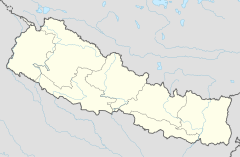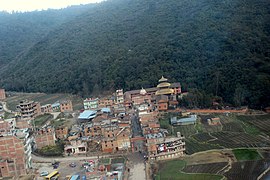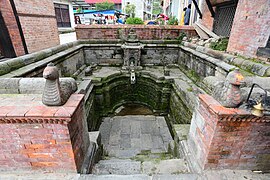
Matsya is the fish avatar of the Hindu god Vishnu. Often described as the first of Vishnu's ten primary avatars, Matsya is described to have rescued the first man, Manu, from a great deluge. Matsya may be depicted as a giant fish, often golden in color, or anthropomorphically with the torso of Vishnu connected to the rear half of a fish.

Kurma, is the second avatar of the Hindu preserver deity, Vishnu. Originating in Vedic literature such as the Yajurveda as being synonymous with the Saptarishi called Kashyapa, Kurma is most commonly associated in post-Vedic literature such as the Puranas. He prominently appears in the legend of the churning of the Ocean of Milk, referred to as the Samudra Manthana. Along with being synonymous with Akupara, the World-Turtle supporting the Earth, Kurma is listed as the second of the Dashavatara, which are the ten principal incarnations of Vishnu.

Varaha is an avatar of the Hindu god Vishnu, in the form of a boar. Varaha is generally listed as third in the Dashavatara, the ten principal avatars of Vishnu.

Parvati, Uma or Gauri is the Hindu goddess of power, energy, nourishment, harmony, love, beauty, devotion, and motherhood. She is a physical representation of Mahadevi in her complete form. She is also revered in her appearances as Durga and Kali. She is one of the central deities of the goddess-oriented sect called Shaktism, and the chief goddess in Shaivism. Along with Lakshmi and Saraswati, she forms the Tridevi.
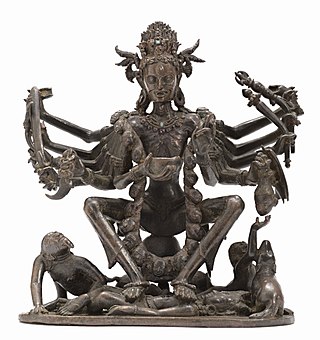
Chamunda, also known as Chamundeshwari, Chamundi or Charchika, is a fearsome form of Chandi, the Hindu Divine Mother Shakti and is one of the seven Matrikas.
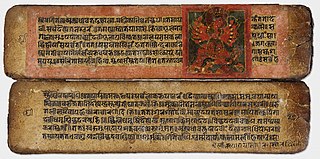
The Devi Mahatmya or Devi Mahatmyam is a Hindu philosophical text describing the Goddess as the supreme power and creator of the universe. It is part of the Markandeya Purana.
Banepa, a municipality and historical town is a valley situated at about 1,500 m (4,900 ft) above sea level in central Nepal which is at about 25 kilometres (16 mi) east from Kathmandu. At the time of the 2011 Nepal census, it has a population of 55,528. The main attraction of Banepa is the temple of Chandeshwori, located approximately 1 km (0.62 mi) northeast of the town along the Rudramati River. The Dhaneshwor Temple is 1 km south of the town. Banepa is also known for its eight different temples of Lord Ganesh, Narayanthan, Bhimshenthan and eight different ponds.

Chandi or Chandika is a Hindu deity. Chandika is another form of Mahadevi, similar to Durga. Chandika is a powerful form of Mahadevi who manifested to destroy evil. She is also known as Kaushiki, Katyayani, AsthadasabujaMahalakshmi and Mahishasuramardini.
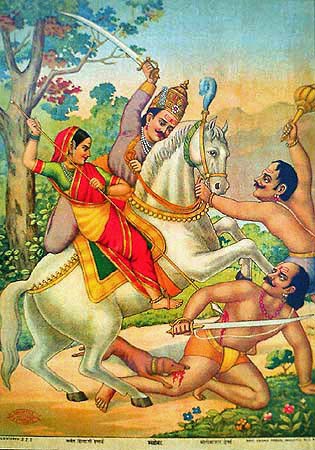
Khandoba, Martanda Bhairava,Malhari, or Malhar is a Hindu deity worshiped as a manifestation of Shiva mainly in the Deccan plateau of India, especially in the state of Maharashtra. He is the most popular Kuladevata in Maharashtra. He is also the patron deity of select warrior, farming castes, Dhangar community and Brahmin (priestly) castes as well as several of the hunter/gatherer tribes that are native to the hills and forests of this region. The sect of Khandoba has linkages with Hindu and Jain traditions, and also assimilates all communities irrespective of caste, including Muslims. The character of Khandoba developed during the 9th and 10th centuries from a folk deity into a composite god possessing the attributes of Shiva, Bhairava, Surya and Kartikeya (Skanda). He is depicted either in the form of a linga, or as an image of a warrior riding on a bull or a horse. The foremost centre of Khandoba worship is the temple of Jejuri in Maharashtra. The legends of Khandoba, found in the text Malhari Mahatmya and also narrated in folk songs, revolve around his victory over demons Mani-malla and his marriages.
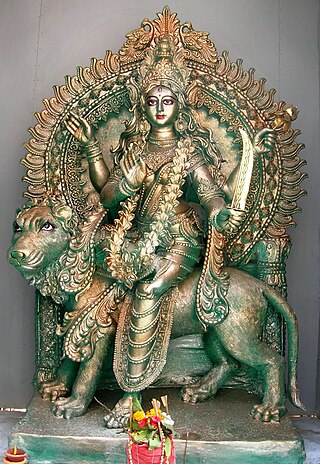
Katyayani (कात्यायनी) is an aspect of Mahadevi and the slayer of the tyrannical demon Mahishasura. She is the sixth among the Navadurgas, the nine forms of Hindu goddess Durga who are worshipped during the festival of Navaratri. She is depicted with four, ten or eighteen hands. This is the second name given for Goddess Adi Parashakti in Amarakosha, the Sanskrit lexicon.

The Skanda Purana is the largest Mukyapurana, a genre of eighteen Hindu religious texts. The text contains over 81,000 verses, and is of Kaumara literature, titled after Skanda, a son of Shiva and Parvati, who is also known as Murugan. While the text is named after Skanda, he does not feature either more or less prominently in this text than in other Shiva-related Puranas. The text has been an important historical record and influence on the Hindu traditions related to the war-god Skanda.
Matrikas also called Matar or Matri, are a group of mother goddesses who are always depicted together in Hinduism. The Matrikas are often depicted in a group of seven, the Saptamatrika(s). However, they are also depicted as a group of eight, the Ashtamatrika(s).
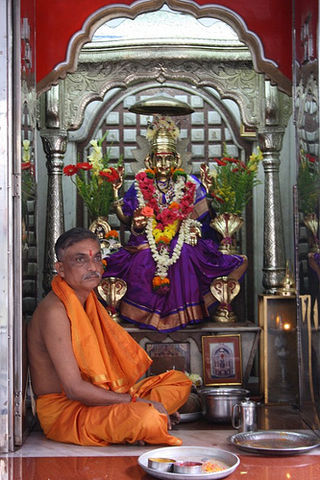
Shantadurga is the most popular form of the Hindu goddess Durga revered in Goa, India, as well some parts of Karnataka. She is a form of the ancient Mother goddess known as Santeri. She is worshipped in almost all villages of Goa as an ant hill. This is seen in some temples dedicated to Shantadurga.

Patal Bhuvaneshwar is a limestone cave temple 14 km from Gangolihat in the Pithoragarh district of Uttarakhand state in India. It is located in the village of Bhubneshwar. Legend and folklore have it that this cave enshrines Lord Shiva and thirty three koti demigods [33 types and not crore]. The cave is 160 m long and 90 feet deep from the point of entrance. Limestone rock formations have created various spectacular stalactite and stalagmite figures of various hues and forms. This cave has a narrow tunnel-like opening which leads to a number of caves. The cave is fully electrically illuminated. Built by the flow of water, Patal Bhuvaneshwar is not just one cave, rather a series of caves within caves.

The Shree Vajreshwari Yogini Devi Mandir is a Hindu temple dedicated to the goddess Vajreshwari, located in the town Vajreshwari, 75 km away from Mumbai. The town, earlier known as Vadvali, was renamed Vajreshwari in honour of the presiding deity of the temple.
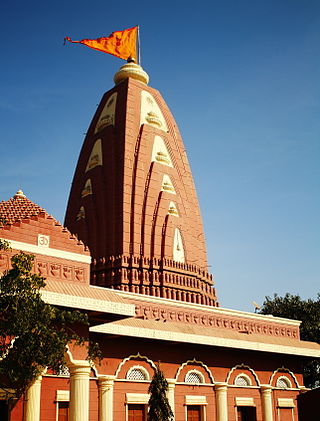
Nageshvara is one of the legendary temples mentioned in the Shiva Purana and is one of the twelve Jyotirlingas. It is located in Dwarka, Gujarat, India.
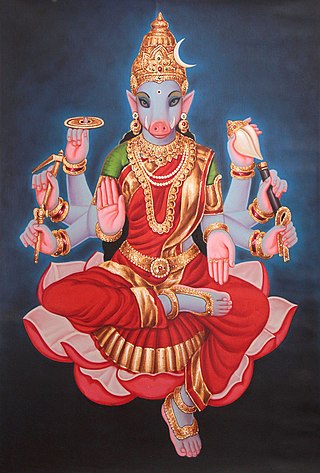
Varahi is one of the Matrikas, a group of seven mother goddesses in the Hindu religion. Bearing the head of a sow, Varahi is the shakti of Varaha, the boar avatar of the god Vishnu. In Nepal, she is called Barahi. In Rajasthan and Gujarat, she is venerated as Dandini.
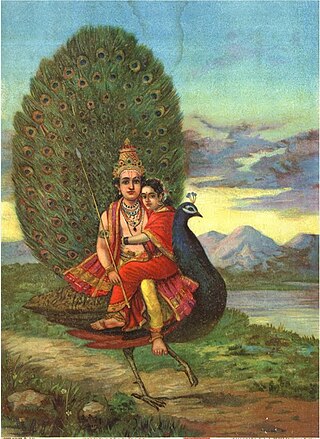
Devasena is a Hindu goddess of aspiration, and the consort of the war god Kartikeya (Murugan). She is also known as Devayanai, Deivanai, and Deivayanai in Tamil texts. Her name is also spelled as Teyvanai or Tevayanai.

Kalaratri is the seventh of the nine Navadurga forms of the mother Goddess Mahadevi. She is first referenced in the Devi Mahatmya. Kalaratri is one of the fearsome forms of the Mother Goddess.

Mahagauri is the eighth form among the Navadurga aspects of the Hindu mother goddess Mahadevi. She is worshipped on the eighth day of Navaratri. According to Hinduism, Mahagauri has the power to fulfill all the desires of her devotees. The one who worships the goddess, gets relief from all the sufferings in life.

